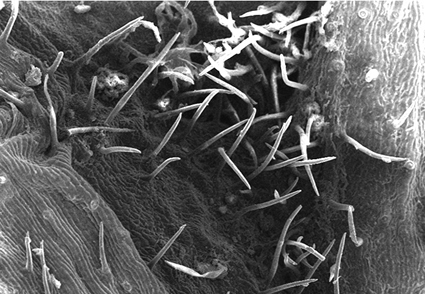Abstract
Psydrax cudalorensis sp.nov. is described and illustrated from Tamil Nadu, India based on morphological and molecular evidence. Although morphologically P. cudalorensis appears to be similar to P. dicoccos, it is different from P. dicoccos in various aspects such as presence of pubescent stem, leaf, peduncle, pedicel, calyx, corolla, fruit and apiculate anther. ITS, rbcL and matK based phylogenetic analysis and SEM study of leaf surface also help to distinguish both the species.
References
<p>Arriola, A.H., Cobangkiat, A.B. & Alejandro, G.J.D. (2017) <em>Psydrax multiflora </em>sp. Nov. (Rubiaceae) from Palawan, Philippines. <em>Nordic Journal of Botany </em>35: 182–184. https://doi.org/10.1111/njb.01255</p>
<p>Arriola, A.H. & Alejandro, G.J.D. (2013) A new species of <em>Psydrax</em> (Vanguerieae, Rubiaceae) from Luzon, Philippines. <em>Phytotaxa</em> 149: 27–30. https://doi.org/10.11646/phytotaxa.149.1.4</p>
<p>Bridson, D.M. (1985) The Reinstatement of <em>Psydrax</em> (Rubiaceae, subfam. Cinchonoideae Tribe Vanguerieae) and a Revision of the African Species. <em>Kew Bulletin</em> 40: 687–725. https://doi.org/10.2307/4109853</p>
<p>Capuron, R. (1969) A propos des Rubiacées-vangueriéesdemadagascar. <em>Adansonia </em>2: 47–55.</p>
<p>CBOL Plant Working Group. (2009) A DNA barcode for land plants. <em>Proceedings of National Academy of Sciences</em> <em>of the United States of America</em> 106: 12794–12797. https://doi.org/10.1073/pnas.0905845106</p>
<p>Champion, H.G. & Seth, S.K. (1968) <em>A revised survey of forest types of India</em>. The Manager Publications, New Delhi.</p>
<p>Dumortier, B.C.J. (1829) Analyse des Familles des Plantes. Tourney, 32 pp.</p>
<p>Gaertner, J. (1788)<em> De Fructibus et Seminibus Plantarum. </em>Vol. 1<em>. Stuttgart: Typis Academiae Carolinae, </em>125 pp. https://doi.org/10.5962/bhl.title.102753</p>
<p>Hooker, J.D. (1875) Observations on some India species of Garcinia. <em>Botanical Journal of the Linnean Society</em> 14: 484. https://doi.org/10.1111/j.1095-8339.1875.tb00346.x</p>
<p>Huang, X.C., Ci, X.Q., Conran, J.G. & Li, J. (2015) Application of DNA Barcodes in Asian Tropical treesa Case Study from Xishuangbanna Nature Reserve, Southwest China. <em>Plos ONE</em> 10: E0129295. [17 pp.] https://doi.org/10.1371/journal.pone.0129295</p>
<p>Jussieu, A.L. (1789) <em>Genera Plantarum</em>. Apud viduam Herissant et Theophilum Barrois, Parisiis. 196 pp.</p>
<p>Lamarck, J.B. (1785)<em> Encyclopédie méthodique par ordre des matières. Vol. 1. </em>602 pp.</p>
<p>Lantz, H. & Bremer, B. (2004) Phylogeny inferred from morphology and DNA data: characterizing well-supported groups in Vanguerieae (Rubiaceae). <em>Botanical Journal of the Linnean Society</em> 146: 257–283. https://doi.org/10.1111/j.1095-8339.2004.00338.x</p>
<p>Mahyunir, C., Nunik, S.A. & Wong, K. (2018) <em>The psydrax dicoccos </em>complex (<em>Rubiaceae</em>) in Malesia, with Three New Species. <em>Floribunda </em>5: 322–331.</p>
<p>Matthew, K.M. (1999) <em>The flora of the Palni hills, South India</em>. Rapinat Herbarium, Tiruchirappalli.</p>
<p>Müller, A.J. (1865) <em>Linnaea; Ein Journal für die Botanik in ihrem ganzen Umfange. </em> 34 (1): 196.</p>
<p>Patil, C.R. & Patil, D.A. (2011) Investigations on foliar epidermis in some Rubiaceae<em>. Journal of Phytology</em> 3: 35–40.</p>
<p>Posada, D. (2008) jmodeltest: Phylogenetic Model Averaging. <em>Molecular Biology and Evolution </em>25: 1253–1256. https://doi.org/10.1093/molbev/msn083</p>
<p>Radlkofer, L.A.T. (1878) <em>Sitzungsberichte der Mathematisch-Physikalischen Classe (Klasse) der K. B. Akademie der Wissenschaften zu München</em> 8: 276.</p>
<p>Richard, A. (1834) Memoire sur la famille des Rubiacies. <em>Mémoires de la Société d’Histoire Naturelle de Paris 5</em>: 190–191.</p>
<p>Romero, G.Q. & Benson, W.W. (2005) Biotic interactions of mites, plants and leaf domatia. <em>Current Opinion in Plant Biology</em> 8: 436–440. https://doi.org/10.1016/j.pbi.2005.05.006</p>
<p>Skeels, H.C. (1912) Seeds and Plants imported. <em>U.S. Department of Agriculture Bureau of Plant Industry Bulletin</em> 248: 25.</p>
<p>Sweet, R. (1826) <em>Hortus Britannicus</em> 2: 289. [London]</p>
<p>Willdenow, C.L. (1800) <em>Species Plantarum</em>. Editio quarta 3: 728.</p>
<p>Zhu, S., Li, Q., Chen, S., Wang, Y., Zhou, L., Zeng, C. & Dong, J. (2018) Phylogenetic analysis of <em>Uncaria</em> species based on internal transcribed spacer (ITS) region and ITS2 secondary structure. <em>Pharmaceutical Biology</em> 56: 548–558. https://doi.org/10.1080/13880209.2018.1499780</p>
<p>Arriola, A.H. & Alejandro, G.J.D. (2013) A new species of <em>Psydrax</em> (Vanguerieae, Rubiaceae) from Luzon, Philippines. <em>Phytotaxa</em> 149: 27–30. https://doi.org/10.11646/phytotaxa.149.1.4</p>
<p>Bridson, D.M. (1985) The Reinstatement of <em>Psydrax</em> (Rubiaceae, subfam. Cinchonoideae Tribe Vanguerieae) and a Revision of the African Species. <em>Kew Bulletin</em> 40: 687–725. https://doi.org/10.2307/4109853</p>
<p>Capuron, R. (1969) A propos des Rubiacées-vangueriéesdemadagascar. <em>Adansonia </em>2: 47–55.</p>
<p>CBOL Plant Working Group. (2009) A DNA barcode for land plants. <em>Proceedings of National Academy of Sciences</em> <em>of the United States of America</em> 106: 12794–12797. https://doi.org/10.1073/pnas.0905845106</p>
<p>Champion, H.G. & Seth, S.K. (1968) <em>A revised survey of forest types of India</em>. The Manager Publications, New Delhi.</p>
<p>Dumortier, B.C.J. (1829) Analyse des Familles des Plantes. Tourney, 32 pp.</p>
<p>Gaertner, J. (1788)<em> De Fructibus et Seminibus Plantarum. </em>Vol. 1<em>. Stuttgart: Typis Academiae Carolinae, </em>125 pp. https://doi.org/10.5962/bhl.title.102753</p>
<p>Hooker, J.D. (1875) Observations on some India species of Garcinia. <em>Botanical Journal of the Linnean Society</em> 14: 484. https://doi.org/10.1111/j.1095-8339.1875.tb00346.x</p>
<p>Huang, X.C., Ci, X.Q., Conran, J.G. & Li, J. (2015) Application of DNA Barcodes in Asian Tropical treesa Case Study from Xishuangbanna Nature Reserve, Southwest China. <em>Plos ONE</em> 10: E0129295. [17 pp.] https://doi.org/10.1371/journal.pone.0129295</p>
<p>Jussieu, A.L. (1789) <em>Genera Plantarum</em>. Apud viduam Herissant et Theophilum Barrois, Parisiis. 196 pp.</p>
<p>Lamarck, J.B. (1785)<em> Encyclopédie méthodique par ordre des matières. Vol. 1. </em>602 pp.</p>
<p>Lantz, H. & Bremer, B. (2004) Phylogeny inferred from morphology and DNA data: characterizing well-supported groups in Vanguerieae (Rubiaceae). <em>Botanical Journal of the Linnean Society</em> 146: 257–283. https://doi.org/10.1111/j.1095-8339.2004.00338.x</p>
<p>Mahyunir, C., Nunik, S.A. & Wong, K. (2018) <em>The psydrax dicoccos </em>complex (<em>Rubiaceae</em>) in Malesia, with Three New Species. <em>Floribunda </em>5: 322–331.</p>
<p>Matthew, K.M. (1999) <em>The flora of the Palni hills, South India</em>. Rapinat Herbarium, Tiruchirappalli.</p>
<p>Müller, A.J. (1865) <em>Linnaea; Ein Journal für die Botanik in ihrem ganzen Umfange. </em> 34 (1): 196.</p>
<p>Patil, C.R. & Patil, D.A. (2011) Investigations on foliar epidermis in some Rubiaceae<em>. Journal of Phytology</em> 3: 35–40.</p>
<p>Posada, D. (2008) jmodeltest: Phylogenetic Model Averaging. <em>Molecular Biology and Evolution </em>25: 1253–1256. https://doi.org/10.1093/molbev/msn083</p>
<p>Radlkofer, L.A.T. (1878) <em>Sitzungsberichte der Mathematisch-Physikalischen Classe (Klasse) der K. B. Akademie der Wissenschaften zu München</em> 8: 276.</p>
<p>Richard, A. (1834) Memoire sur la famille des Rubiacies. <em>Mémoires de la Société d’Histoire Naturelle de Paris 5</em>: 190–191.</p>
<p>Romero, G.Q. & Benson, W.W. (2005) Biotic interactions of mites, plants and leaf domatia. <em>Current Opinion in Plant Biology</em> 8: 436–440. https://doi.org/10.1016/j.pbi.2005.05.006</p>
<p>Skeels, H.C. (1912) Seeds and Plants imported. <em>U.S. Department of Agriculture Bureau of Plant Industry Bulletin</em> 248: 25.</p>
<p>Sweet, R. (1826) <em>Hortus Britannicus</em> 2: 289. [London]</p>
<p>Willdenow, C.L. (1800) <em>Species Plantarum</em>. Editio quarta 3: 728.</p>
<p>Zhu, S., Li, Q., Chen, S., Wang, Y., Zhou, L., Zeng, C. & Dong, J. (2018) Phylogenetic analysis of <em>Uncaria</em> species based on internal transcribed spacer (ITS) region and ITS2 secondary structure. <em>Pharmaceutical Biology</em> 56: 548–558. https://doi.org/10.1080/13880209.2018.1499780</p>


